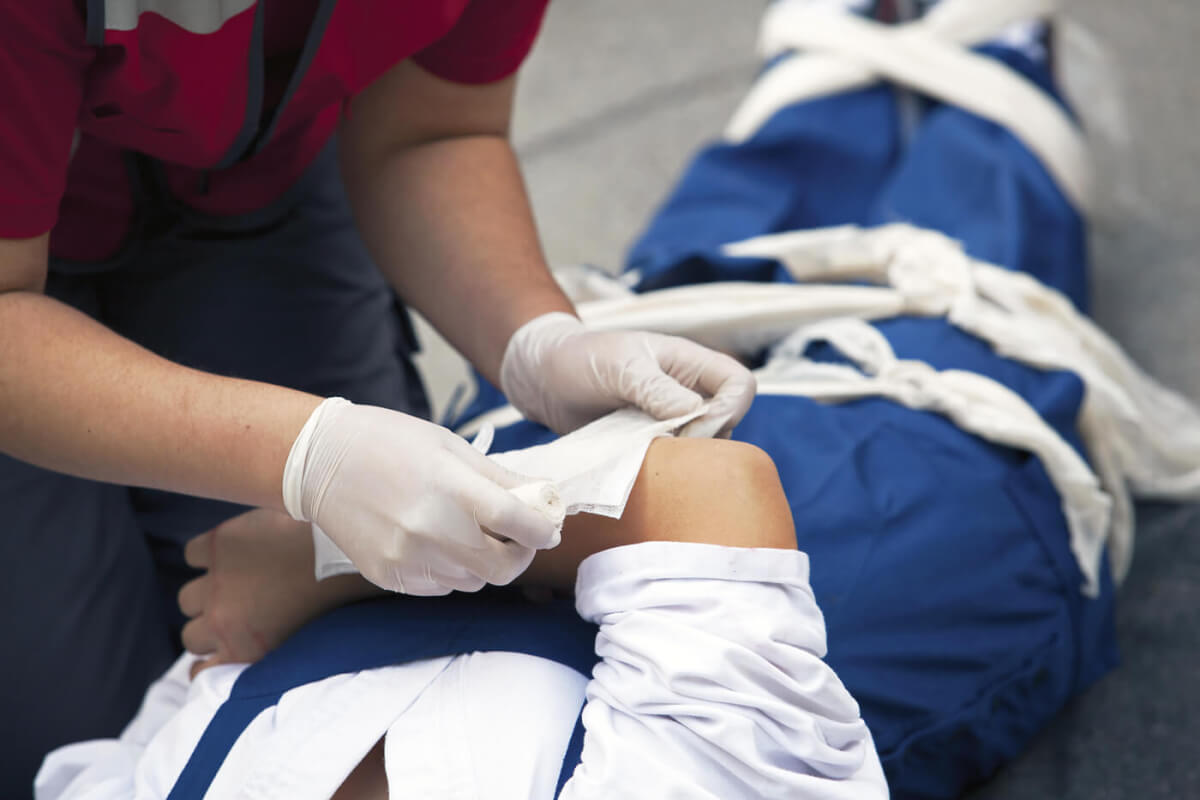If you’re in a bug-out location and an emergency medical situation arises, wouldn’t you want the latest and greatest first-aid technology available at your fingertips?
Techniques and products for the care and treatment of traumatic injuries, such as a hemorrhage, broken bones and breathing problems, have advanced greatly in the past decade. This is due in a large part to serve military needs. As a result, the civilian sector can now also benefit from these advances with better equipment, training and resources.
PRESSURE DRESSINGS
One of the first things you should do with a deep bleeding wound is to apply direct pressure to the wound to stop the bleeding. In the past, that would have entailed pressing a sterile dressing and then wrapping it as tightly as possible. Today, we have pressure dressings like the Israeli Bandage or the Olaes Modular Bandage, which are designed to not only help apply pressure directly onto the wound but also help tighten the wrapping to apply more pressure.

To accomplish this, the Israeli Bandage has a pressure applicator and closure bar combination while the Olaes utilizes an elastic band like an ACE bandage for tightening.
The Olaes is also a kind of all-in-one trauma bandage; it includes an occlusive dressing for chest wounds and folded gauze for packing deep wounds and stopping massive bleeding.
TOURNIQUETS
Still a tool of last resort but improvisable with whatever is available, the tourniquet is now standard issue to every combat soldier and is found in pretty much every trauma or blow-out kit on the commercial market. This has come about thanks to research done during combat in Iraq and Afghanistan that showed the importance of being able to rapidly stop the flow of blood from major blood vessels when pressure dressings were not effective.
It used to be that tourniquets often caused a limb to have to be amputated, but due to improved tourniquet designs that make them easier to apply in a timely manner, reduced tissue damage through the use of wider compression bands and the advent of better training— ensuring the user doesn’t apply the tourniquet incorrectly or for too long—this is thankfully a thing of the past.

There are three brands of tourniquets that have worked their way to the top of the list: the Combat Application Tourniquet (C-A-T), the Special Operations Forces Tactical Tourniquet – Wide (SOFTT-W) and the Military Emergency Tourniquet (MET). These all slip over the limb and get tightened with a windlass device. Get one, learn to use it properly and keep it available wherever you are doing something that might result in a massive bleeding injury.
The Stretch-Wrap-And-Tuck Tourniquet (SWAT-T) is a multi-purpose bandage that can be used as a tourniquet, a pressure dressing or an elastic bandage for when a limb needs to be wrapped and secured; it works like a splint. Its main advantage is that you can apply it to places like the upper thigh, where a conventional tourniquet would be a difficult fit.
CLOTTING AGENTS

Clotting agents, or hemostatic agents, are examples of what DuPont used to refer to as “better living through chemistry.” They consist of chemicals or minerals that speed the process of clotting in a wound by augmenting the blood’s natural clotting ability. Initially, these agents used heat to help cauterize the wound in addition to upping the clotting factor in the blood, but that’s old technology.
Today, leading clotting agent brands include QuikClot and Celox. They can be found in powder form for placement into the wound and impregnated into gauze for stuffing into the wound, or they can be integrated into pressure dressings.
CPR AND AEDs
Cardiopulmonary resuscitation (CPR) used to entail just rescue breathing or mouth-to-mouth resuscitation. Now, with better training and constantly evolving techniques, the discipline integrates chest compressions along with rescue breathing to greatly improve the patient’s chances of survival.
Plastic and fabric mouth barriers to protect the rescuer are available to the public, and it’s a good idea to get some. Since the invention and ready availability of automatic external defibrillators (AEDs), this topic is also part of the standard CPR course, as one might need to use this method when the patient loses consciousness or stops breathing.
ADVANCED TRAINING
In addition to the classes that the American Red Cross and the American Heart Association have given for years on basic and advanced first aid, CPR and, now, AED use, there are new training resources popping up every year.
Most colleges offer courses for those interested in becoming an EMT, and many companies now provide training on how to handle medical traumas like chest wounds and arterial bleeding. This type of training is really a must for those who spend a lot of time outdoors, practice with weapons of any kind or use power tools on a regular basis.
STAY SAFE
Even if you aren’t fighting the Taliban in Afghanistan, these new first-aid technologies can help keep you and those around you safer when hiking in the backcountry, working around heavy equipment or power tools or defending your home or bug-out location.
Modern medical technologies, especially those focused on trauma care, deal with solving problems found in the ABCs of first aid, which show you what to deal with first, second and third:
Airway: Ensure the airway is clear of any obstructions.
Bleeding: Identify and stop any bleeding.
Circulation: Ensure that the blood continues to circulate throughout the body.
If you want to get your hands on some of this new tech and integrate it into your own first-aid kit and trauma gear, check out the following vendors:
Editor’s note: A version of this article first appeared in the April 2014 print issue of American Survival Guide.


